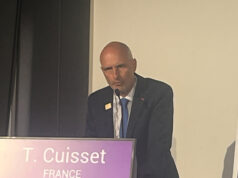
At this year’s EuroPCR (16–19 May, Paris, France), Philip MacCarthy writes, I had the pleasure of welcoming onto the podium a team of determined cyclists from the UK charity Heart Valve Voice. The group of patients, physicians, nurses and supporters had cycled from St Thomas’ Hospital in London to Paris to raise awareness of the need to more effectively treat people with heart valve disease.
The charity could not have chosen a more opportune moment for their campaign. In the interventional cardiology world, we are experiencing an almost perfect storm of developments that are turning this into a transformative phase for physicians and patients alike. For more than 50 years, surgical aortic valve replacement ruled supreme in treating severe symptomatic aortic stenosis, but around a third of patients could not be treated because of their age, frailty and comorbidities. The development of transcatheter aortic valve implantation (TAVI) has transformed the landscape for patients. When we undertook our first TAVI procedure at King’s College Hospital (London, UK) in 2007, the concept was a promising, pioneering idea with limited data to support it—but things have changed in the last 10 years. Patient outcomes have improved exponentially, with survival at one year reaching between 91% and 93%. Complications such as disabling stroke, paravalvular leak and pacemaker rates have all decreased.
Many more patients undergo TAVI under conscious sedation, which avoids complications and contributes to reducing length-of-stay. At King’s, we see many patients go home within a matter of days of a procedure. From Rouen (France)—the nursery of TAVI—Durand et al reported that 36% of carefully-selected patients returned home within three days, with no negative impact on outcomes. 1 A centre in Lyon (France) has even reported a patient being admitted, treated and discharged on the same day.
Although we are some way from ambulatory care being the norm, TAVI treatment is certainly being extended to more patients. Initially, we undertook TAVI only on inoperable patients, before extending to those at high surgical risk. Since then, the PARTNER II trial demonstrated that TAVI was superior to surgery in intermediate-risk patients.2 As a result, earlier this year, the American College of Cardiology’s guidelines recommended that TAVI be considered for intermediate-risk patients; we expect that the European Society of Cardiology (ESC) and the European Association for Cardio-Thoracic Surgery (EACTS) will follow suit with a similar recommendation when they publish their updated joint guidelines (August 2017).
We will see more than 3,000 people treated with TAVI in the UK this year alone, and I expect this number to increase as Heart Valve Voice’s awareness campaign unearths more people who had not been referred to appropriate specialists or who had incorrectly put their symptoms down to ageing.
We must remember that interventional cardiology developments are not restricted to TAVI and the aortic valve alone. Transcatheter mitral valve repair has been available for some time to treat mitral regurgitation and has demonstrated significant improvement of symptoms, often in patients not fit enough to undergo conventional surgery.3 There is promise of much more to come, with many companies investing in innovative technology, many of which are already well established in clinical trials. Moreover, there have been significant developments in the field of transcatheter mitral valve replacement with several promising devices in the CE mark stage of development. We are still at the very early stages of mitral and tricuspid transcatheter intervention and there are many challenges ahead with the complex valve anatomy and less well-defined disease patterns—often involving substantial disorders of the ventricles and heart muscle. However, with such a large interest in innovative device technology and carefully designed clinical trials, we are seeing steady progress. Many more companies are investing in the field than was the case with TAVI, creating a competitive market with a lot of promise for the future.
So, in this “golden era” for heart valve disease treatment, it could not be a more exciting time to be an interventional cardiologist. If the heart team can continue to work in partnership with industry and patients advocates like Heart Valve Voice, we can completely transform the landscape for valve disease patients and our ageing population.
References
- Durand et al. American Journal of Cardiology; 115(8): 1116–-22.
- Thourani et al. The Lancet 2016; 387: 2218–25.
- Feldman et al. J Am Coll Cardiol 2015; 66: 2844–54.
Philip MacCarthy is at King’s College London and King’s College Hospital, London, UK










